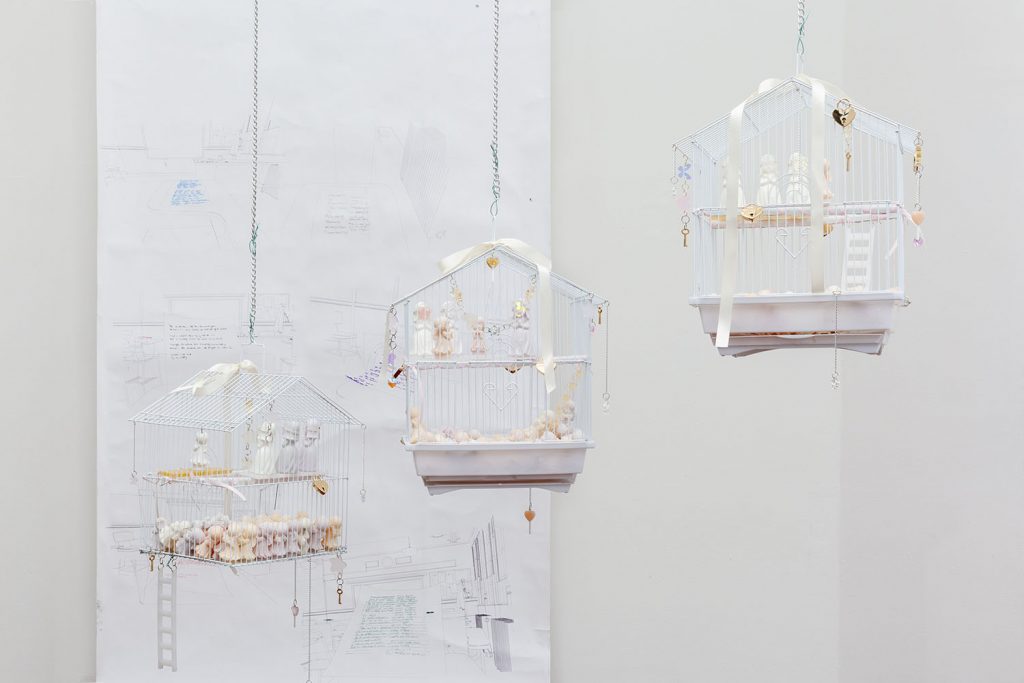The pairing doesn’t seem to make sense, at least at first. Emma Pryde’s birdcages hang from the ceiling of New York’s Alyssa Davis Gallery for Dream of the Palace, a joint exhibition with Willard Klein. Stuffed with small pastel angel and priest figurines and draped with dangly chains, these improvised dollhouses evoke Christian giftware such as Precious Moments. Through their pink and purple bars peak Klein’s huge rolls of paper, unfurled like oversized scrolls. Upon them spread spidery marks resembling the delicacy of Pryde’s work, though deployed to an altogether different end.

These drawings call attention to the architecture of the gallery, not just in how they run the length of its walls, but also in their technical content. They might be blueprints, especially when considering one of the piece’s own bruised hue. Where we would expect clarity, however, is instead confusion; the perspective is a bit off, figure and ground refuse to stay put, the ink blurs. Mysterious objects proliferate as if intruders from another image or the aftermath of a science experiment gone horribly wrong—Klein as the Sorcerer’s Apprentice, having set in motion an automated process that slowly slips out of his grasp.
Perhaps a similar dynamic is present within Pryde’s work. Here too, there’s a feeling of frantic duplication, a control that betrays loss of control. Qin Shi Huang, the first emperor of China, made a life-sized army of terracotta warriors to protect him beyond the grave. Maybe Pryde’s tiny toys function analogously; the playthings children place between themselves and a world of unknown fears. Like a toddler that obstinately continues to suck its thumb, this coping mechanism has apparently extended so long it’s created enough of these sacred miniatures to line the bottoms of their cages like so many animal droppings. The collection, of course, references mass production, especially of toys, which bring hard consumerism and soft sentimentality together into an uneasy balance.

If we interpret Pryde as at once destabilizing and confirming the uniqueness of the work of art through the readymade and the cast multiple, we might argue that Klein does so through the digital (though Pryde also uses digital technologies like laser cutters). Indeed, techniques such as computer numerical control remove the artist’s hand tout court. Even the writing we see is frustratingly illegible and seems to gently drift off the page. Lines extend in the suggestion of a representational shape, only to abruptly end or get tangled up with one another. And yet, by using these sophisticated tools not as intended, Klein reasserts the role of the artist as a figure who invites us to question what we take for granted.
To add another layer, both artists remain rooted in art history. Consider how Pryde’s acrylic altarpieces echo medieval and Renaissance painters like Duccio, Raphael, and Piero della Francesca. Or how Klein pays homage to abstract modernism with his dense, choppy minimalism. In different yet complementary ways, Klein and Pryde demonstrate how art can provide a space within which to reimagine our relationships with the past, even if we shift from our conception of the artist away from heroic creator and toward strategic reorganizer. They offer, in other words, a way to make art without artists.**













